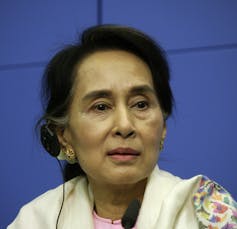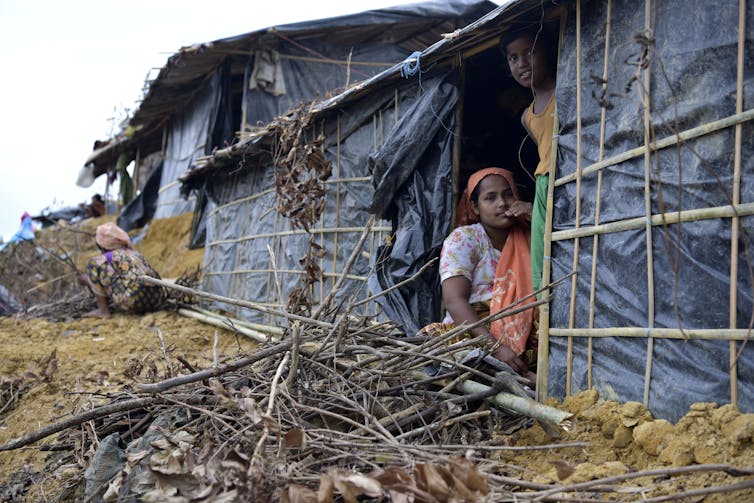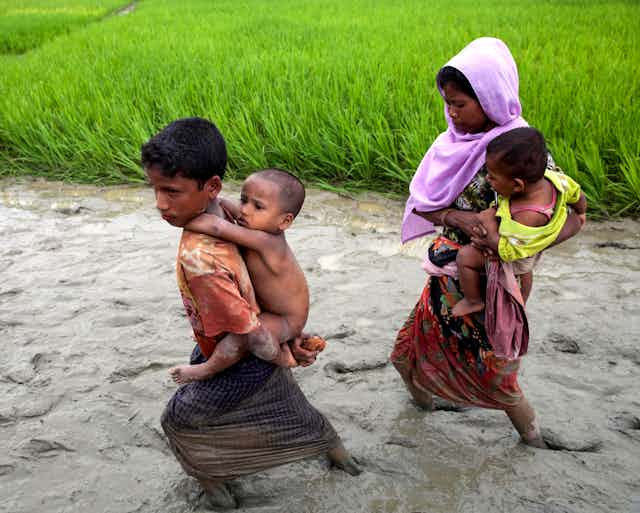This is not the first clash between members of the stateless and discriminated Muslim community and Myanmar’s armed forces, nor the first Rohingya refugee crisis. Yet the latest military offensive is unprecedented in brutality and scale.
An account of the timing of the current crisis should consider how Myanmar’s government found itself in such a favourable global environment, with its giant neighbours India and – crucially – China embracing the government’s official narrative. A politically distant and distracted US administration was also convenient.
Disenfranchisement and discrimination are nothing new for the Rohingya population, a community of 1.3m people settled in predominantly Buddhist Myanmar’s Rakhine state.
With domestic dynamics and popular attitudes towards the Rohingyas unchanged since violence erupted in 2012, and ample opportunities in recent years to cleanse the Rohingya population of Rakhine state, why is the Nay Pyi Taw government pushing ahead now? Why not before?
The Rohingya crisis needs to be seen in the context of a rapidly evolving geopolitical environment, where the government in Nay Pyi Taw felt it could bear the costs of a tarnished international image without incurring sanctions, save an international outcry over human rights. This was made possible by two main factors.
Timing is of the essence
First, the US is uninterested in Myanmar. President Trump has no time with other priorities at hand, from North Korea’s nuclear threat to its evolving relations with China.

In contrast, the Obama administration was closely involved in shepherding the Thein Sein government on the way to political liberalisation. This culminated with the 2015 parliamentary elections and a formal handover to a new government in March 2016, led by Aung San Suu Kyi’s National League for Democracy.
Although clashes and crises erupted in 2012, 2015 and 2016, the Myanmar authorities felt constrained by the much-needed international assistance that was crucial to political change. The lifting of sanctions in October 2016 opened the gates to a significant inflow of help in the form of aid, investment, trade and more generally, goodwill in the wake of one of Asia’s most unexpected transitions.
But actively supporting or defending democracy and human rights abroad does not feature highly in the Trump administration’s list of priorities. Myanmar, cornered between India and China, has turned from being at a strategic crossroads to a backwater too far from Washington’s preoccupations. Opportunity is key in politics, and a US policy shift compounded by a more immediate crisis in North Korea meant that a window of opportunity for settling the Rohingya question opened.

Superpower support
The second factor which made the routing of the Rohingya Muslims possible was the unequivocal support from China, Russia and India, which emboldened Myanmar’s generals and sheltered Myanmar’s international position.
China is Myanmar’s most important political, security and economic partner. Beijing’s support is essential if Myanmar’s many intractable conflicts are to be resolved, as “peace-building” (with all but the Rohingyas) is a priority of Aung San Suu Kyi’s government.
Close observers of Myanmar’s domestic and international developments cautioned against overstated enthusiasm over Myanmar’s turnaround in its alliances. In fact, Myanmar never quite turned its back on Beijing. Although India has accepted a few thousand Rohingyas in the past and China has committed to covering part of the costs Bangladesh is incurring in the current crisis, both New Delhi and Beijing have firmly embraced the official narrative of Myanmar’s government.
Likewise, Russia is also keen on sheltering Myanmar from any international sanctions. What left many of Aung San Suu Kyi’s long-time supporters dismayed was the ease with which, facing the prospect of censure by the UN, she warned off critics, indicating that she would turn to Russia and China’s veto power, if needed.
Bangladesh’s predicament
Neighbouring Bangladesh now finds itself between a rock and a hard place. Dhaka is bearing the brunt of the crisis, having taken in more than 400,000 refugees in less than three weeks, with little prospect of them returning home in the foreseeable future.

Although bilateral relations have been occasionally bumpy (Myanmar and Bangladesh compete for international aid and investment, and cross-border crime such as drugs trafficking is a sore point in bilateral ties), political and economic ties between the two countries are on the up. And despite domestic pressure to be more vocal on the Rohingya issue, Bangladeshi authorities have refrained from actions that may endanger growing commercial ties.
Acutely aware that the window of opportunity would not remain open forever, Myanmar’s armed forces decided to take their chance. They were happy to bear the costs of a tarnished international image and the implosion of the global reputation of Myanmar’s democracy – as well as that of human rights icon Aung San Suu Kyi – in return for relocating a large segment of the unwelcome Rohingya population.
A popular move at home, ethnic cleansing got under way as the world turned away.

